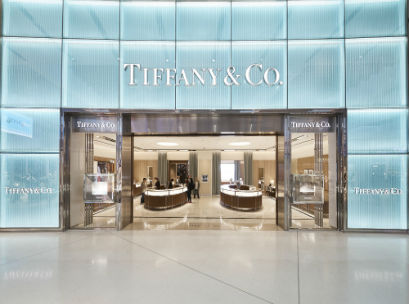 New York-based luxury jeweller Tiffany & Co has reported improved second-quarter results, with its sales and net income both posting gains, beating Wall Street expectations.
New York-based luxury jeweller Tiffany & Co has reported improved second-quarter results, with its sales and net income both posting gains, beating Wall Street expectations.
Tiffany’s on Thursday reported a net income of $US115 million, or 92 US cents per share, compared with $US105.7 million, or 84 US cents per share, a year ago.
The average estimate of 10 Wall Street analysts surveyed by Zacks Investment Research was for earnings of 88 US cents per share.
The company posted revenue growth of three per cent to US$959.7 million in the period, also exceeding Wall Street forecasts. Six analysts surveyed by Zacks expected US$933.2 million. Tiffany credited the growth to higher sales of wholesale diamonds, stronger wholesale sales in Asia-Pacific and strong e-commerce sales growth.
However, sales in stores open at least a year, a key metric of a retailer’s health, declined two per cent during the quarter.
Jefferies analyst Randal Konik said the results show Tiffany’s stores in the Americas are stabilising, and high-margin fashion jewellery sales are gaining momentum.
Tiffany officials said customer traffic returned to normal levels at the chain’s flagship New York store that experienced disruption last fall because of security around President Donald Trump’s personal home and offices on the same block.
For the full fiscal year, the retailer forecast growth in its adjusted earnings per share in the mid-single-digits-percentage with sales up in the low-single-digit percentage.
Tiffany shares ended Thursday down US$1.17, or 1.3 per cent, at US$87.55. They have climbed 13 per cent since the beginning of the year, while the Standard & Poor’s 500 index is up 9 per cent. The stock has increased 27 per cent in the last 12 months.
 Neil Saunders, managing director of GlobalData Retail, said Tiffany’s more positive results show the early promise of progress at a company that has often struggled to remain relevant in the modern era of retail.
Neil Saunders, managing director of GlobalData Retail, said Tiffany’s more positive results show the early promise of progress at a company that has often struggled to remain relevant in the modern era of retail.
“That said, there are still some areas of residual softness, especially in terms of same-store sales and particularly across the Americas,” Saunders said. “As Tiffany management recognizes, there is a lot more work to do before the company is back on the ground of firm, sustainable growth.”
Saunders said one of the more promising areas of progress is the company’s attempts to better connect with younger consumers – a constituency with which it had lost traction. Some of this is down to improved product – with the more contemporary, fashion-focused “Return to Tiffany” collection of silver jewelry having been well received. Collections by designers like Elsa Peretti and Paloma Picasso have also stimulated interest and have added a much-needed contemporary edge to Tiffany’s product mix.
“With improvements to the assortment, Tiffany also understands that it needs to communicate to younger shoppers to increase the resonance of the brand,” Saunders said. “Here we are encouraged by marketing campaigns, including fall advertising featuring Janelle Monáe, Zoë Kravitz, & St. Vincent (Annie Clarke). These campaigns have a much more modern feel and successfully highlight the changes that are being made on the product front.”
According to Saunders, it will take time for the changes to percolate through to customers and to drive sales – not least because jewelry is an infrequent purchase.
“However, we are pleased that Tiffany has made the changes in time for the important holiday season and believe the chain will reap some rewards over the final half of its fiscal year.”
Saunders said one of the areas where they have long been critical is store design. While they are neat and well maintained, he said, many of Tiffany’s stores look old fashioned and, for the younger consumer, can be intimidating. In essence, they convey a message of old-world luxury which is increasingly at odds with what consumers want and with what many competitors are delivering.
“The company now seems to have recognized this with the ongoing remodeling of some of its main stores,” he added.
Saunders said the Union Square shop in San Francisco, which was redesigned earlier in the year, has been well received and is delivering results.
“In our view, the design strikes exactly the right balance between something that feels youthful and modern but which maintains an air of exclusivity and luxury,” he said. “If this thinking can be rolled out to other stores, including non-flagship locations, we believe Tiffany can make real progress in terms of driving up same-store numbers.”
He added for all of the advancements, there is much more to be done, and Tiffany remains a work in progress.
“However, we believe that there is now a sense of momentum and energy at the company that was simply not there a few years ago. The new management team is responsible for this, and the recent appointment of Alessandro Bogliolo as CEO should ensure that change continues at pace.”
Access exclusive analysis, locked news and reports with Inside Retail Weekly. Subscribe today and get our premium print publication delivered to your door every week.





